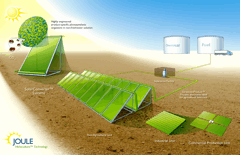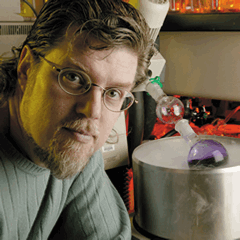Biofuel Bugs
Air Date: Week of November 27, 2009

Scientists at Joule Biotechnologies say their mystery microbe spits out ethanol and diesel in the lab. This is how the Joule system might work in the field. (Courtesy Joule Biotechnologies)
Genetically modified microbes are the new thing in biofuels. Some university labs and high-tech startups say they’ve engineered organisms that can make fuels like ethanol and diesel with just sunlight and carbon dioxide. It’s called direct solar liquid fuel. The technology is a long way from commercial development but it’s already creating a buzz in the biofuels business.
Transcript
YOUNG: America has long dreamed of growing its way to energy independence—ethanol, biodiesel and other plant-based fuels to wean us from climate-changing, budget-busting oil.
But biofuels have baggage. They take lots of energy, fertilizer, farmland and water. Well now some university labs and hi-tech companies promise a way past those problems. These ambitious scientists and entrepreneurs use genetic engineering to get fuel straight out of tiny plants and microbes. It’s a process called direct solar liquid energy.
[Walking steps]
YOUNG: Joule biotechnology’s CEO, Bill Sims, gives me the tour of his Cambridge, Massachusetts lab.
SIMS: So, in this lab we are actually testing our solar converters.
YOUNG: Sims points to tabletop sized rectangular, plastic frames, each with dozens of clear, skinny tubes running their length. Each tubes bubbles with a greenish liquid.
[Bubbling sounds]
YOUNG: The bubbles are carbon dioxide; the greenish color comes from a tiny, genetically modified organism. Plants or bacteria, maybe. Sims won’t say just what.

University of Minnesota biochemistry professor Larry Wackett’s team won support from the US Dept. of Energy for their approach to direct solar fuel. Wackett’s wants to mimic symbiosis in nature by teaming up microbes. (Courtesy UM College of Biological Sciences)
SIMS: So, we use the tools of synthetic biology in order to start with a base organism, but actually by modifying pathways, create new organisms that we have engineered to directly secrete fuels and chemicals.
YOUNG: One engineered organism can make ethanol. Another makes diesel fuel. Sims envisions these panels in a sunny somewhere soaking up CO2 from a power plant, and sending a constant stream of fuel-laden water to a separation facility. He says an acre of the solar converters could produce many times what biofuel crops do.
SIMS: So there’s no intermediary like cellulose or like algae that has to be grown, has to be processed as part of their process to create fuels or chemicals. We also don’t require fresh water, we don’t require agricultural land. We are converting CO2, and what is viewed by most people as bad into something good: renewable, clean fuel.
YOUNG: So let me see if I’ve got this straight. CO2, sun, your genetically tweaked organism – poof -- out the other end comes fuel?
SIMS: Yep, this is revolutionary technology, there’s no doubt about it. Call it what you will, transformational, game changing, etc. But it’s an entirely new way, using the power of the sun in a unique way, we aren’t converting sunlight to electrons, we’re converting sunlight to liquid fuels in a cost-effective manner that has essentially and unlimited supply.
YOUNG: I’ve got to say, it sounds a little too good to be true. But, you’re saying this works for real.
SIMS: It works for real. We get continued improvements on our productivity, and we’re finalizing our negotiations to break ground on a pilot plant in early 2010.
YOUNG: But, you’re still not going to tell us what the organism actually is?
SIMS: That’s right, the critter is still a secret.
YOUNG: But, it’s not an algae?
SIMS: It is not algae.
YOUNG: Is it duckweed?
SIMS: All we say is that it’s a highly engineered, photosynthetic organism that’s not algae.
YOUNG: Sims is tight-lipped when it comes to intellectual property, a common trait among the handful of companies trying this technology. In academia, things are a bit more open source.
Biochemistry professor Larry Wackett leads a team at the University of Minnesota, taking a different approach to direct solar fuels. Wackett says, no matter how much you modify an organism, you can only teach it so many tricks.

Scientists at Joule Biotechnologies say their mystery microbe spits out ethanol and diesel in the lab. This is how the Joule system might work in the field. (Courtesy Joule Biotechnologies)
WACKETT: If you try to engineer that organism to do many additional things, it puts stress on it and it’s often very difficult to highly engineer that to do all of the things that you want.
YOUNG: Wackett’s working on a bacterial buddy system. A genetically modified cyanobacteria, the ancient bugs that were the Earth’s first photosynthesizers, and a bacteria called Shewanella, which is good at churning out the building blocks of hydrocarbon fuels.
WACKETT: Now if you take a photosynthetic organism, something that harvests sunlight and then you take another organism that will now take the energy from the photosynthetic organism – the carbon – and convert that into something that you want like a hydrocarbon, this could be a very effective team.
YOUNG: Are you kind of mimicking symbiosis in nature, here?
WACKETT: Yes, we are. In fact, in a way we’re kind of learning from nature. We want to see how nature does things then more or less adapt it to a specific task. So rather than trying to fight this, we’re saying, hey, let’s go with the flow and use it.
YOUNG: Professor Wackett’s Minnesota team was among three universities to win highly competitive grants last month from the Department of Energy to develop direct solar liquid fuels. And the Minnesota lab has spun out a small company called, BioCee.
I called up Jim Lane to get a feel for how these direct solar startup companies are doing. Lane keeps tabs on the industry as editor of the Biofuels Digest. He says the companies already have a nickname: “The Magic Bug Guys”. And they’re generating a lot of buzz.
LANE: The energy has been building up for several years in research. And the two companies that have gotten a lot of attention lately: Joule Biotechnologies and also BioCee – they’ve really proven at the bench-scale that their technology really works.
YOUNG: So, what is the general reaction within the industry to what Joule and other companies say they can do here?
LANE: The idea that there are a couple of companies out there that are getting close to doing it and may have actually come up with a solution is incredibly exciting. But there is of course that healthy skepticism of any company that is not yet, at this point, building out to scale.
If you compare this to, let’s say, the Apollo Moon Shot program, we’d be in about 1962, which is when the Saturn Five was first announced. We’ve got a long ways to go before we’re actually landing on the Moon and can declare victory, but we’re at a milestone point, for sure.
YOUNG: Lane says the Magic Bug approach is attracting a lot of venture capital; bets that the answer to our biggest energy problem might come from a very tiny package.
Links
Living on Earth wants to hear from you!
Living on Earth
62 Calef Highway, Suite 212
Lee, NH 03861
Telephone: 617-287-4121
E-mail: comments@loe.org
Newsletter [Click here]
Donate to Living on Earth!
Living on Earth is an independent media program and relies entirely on contributions from listeners and institutions supporting public service. Please donate now to preserve an independent environmental voice.
NewsletterLiving on Earth offers a weekly delivery of the show's rundown to your mailbox. Sign up for our newsletter today!
 Sailors For The Sea: Be the change you want to sea.
Sailors For The Sea: Be the change you want to sea.
 The Grantham Foundation for the Protection of the Environment: Committed to protecting and improving the health of the global environment.
The Grantham Foundation for the Protection of the Environment: Committed to protecting and improving the health of the global environment.
 Contribute to Living on Earth and receive, as our gift to you, an archival print of one of Mark Seth Lender's extraordinary wildlife photographs. Follow the link to see Mark's current collection of photographs.
Contribute to Living on Earth and receive, as our gift to you, an archival print of one of Mark Seth Lender's extraordinary wildlife photographs. Follow the link to see Mark's current collection of photographs.
 Buy a signed copy of Mark Seth Lender's book Smeagull the Seagull & support Living on Earth
Buy a signed copy of Mark Seth Lender's book Smeagull the Seagull & support Living on Earth

